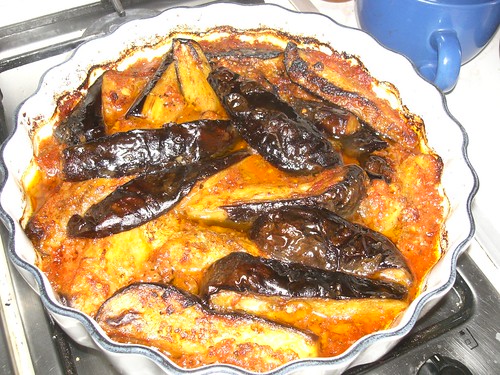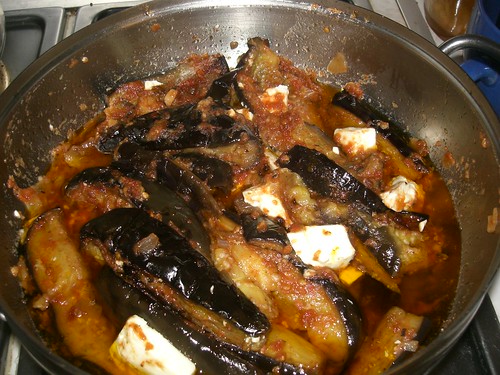Nowadays, sadly, young people are not so involved in the food customs of the family. More and more food is being sold ready-to-eat, and people do not have to go far to find any food product they desire, due to the ease of shopping in supermarkets. The traditional food of every regional pocket of Greece is either mainly seen as an 'old-people' thing because of the newer more globalised food trends taking hold in Greece, or something that is cooked at large gatherings and isn't often made by people in their homes, hence there is a lack of tradition in the passing of knowledge from one generation to another.
Greek souvenir cookbooks tend to be too generic: the full range of Greek cuisine has never really been showcased in such books, since most present an often nationalised segment of regional cooking, containing the odd exceptional dish.
Greek cookbooks tend to be sold in the region where they are produced, and because of low demand, regional cookbooks about Greek cooking, other than those produced in the region where one lives, are difficult to find. In Hania, for example, I can find just about any book my heart desires about Cretan food, but not, say, about the food customs of the island of Zakinthos, to name one example. Such cookbooks will also have a low demand commercially outside their native region, so that they are not widespread, even in large bookshops. I can't browse Greek cookbooks in a bookshop in Hania - I have to go to Athens for that kind of shopping. Thankfully, we have people like Ilias Mamalakis and other Greek chefs who also do gastro-travel programmes and give away recipes on the show. And now, for the first time on the internet, we have a Greek Food Blogs portal, which anyone writing on the web about Greek food can join, showcasing the food that is being prepared by home chefs cooking Greek food from all over the world.
*** *** ***
The other day, a repeat of Ilias' television programme Mπουκιά και Συχώριο was showing at midday while we were having lunch. Ilias was in Zakinthos, an island in the Ionian Sea (Western Greece) which is also known as Zante. Ilias first had a taste of a local sweet called φυτούρα (fitoura - also known as fritoura), a completely unknown traditional delicacy of the island, made primarily in this area and not elsewhere, which is available all year round, and is especially popular during the fasting periods because it does not contain animal products. Fitoura is a dense semolina pudding, which is poured into a tin and allowed to cool. It is then cut up into diamond shapes and the fitoura pieces are fried in oil (not necessarily olive oil). When cool enough to handle, the fitoura is rolled in sugar before it is served. It sounds so simple, but it is never made outside Zakinthos. It is a local treat, made primarily in large quantities and served at festivals, from where it is never missing.
After Ilias ate his fitoura, with the help of a local cook, he made aubergines 'skordostoubi', another specialty of Zakinthos: eggplant cooked in a garlicky vinegar tomato sauce. This seemed like a perfect alternative for us to try now that we have a glut of eggplant in our summer garden. Eggplant grows easily in Crete and it is one of those vegetables that landmarks a Greek summer, including the Cretan kitchen. It is always difficult to keep accurate notes when watching a television cookery show, so I asked my Zakinthian friend Kiki to help me out. This dish requires a lot of olive oil and a lot of frying, neither of which are these days very popular in excess for health reasons. Through Facebook (finally, I found a valid use for it!) Kiki gave me some tips to reduce the excess frying.
For 3 average servings, you need:
3 large eggplant, cut into thick slices (not small, not cubes)
1 large onion coarsely chopped
2-3 cloves garlic coarsely chopped
half a wineglass of vinegar
2 tomatoes, grated
100-150g feta cheese cut in cubes (in Zakintho, they use a local product called ladotiri, cheese preserved in olive oil, but it is doubtful that you will be able to find an authentic alternative such as this one outside the region - feta is a good substitute)
olive oil
salt and pepper
oregano
Heat some olive oil - you will need quite a bit because eggplant soak up a lot of oil - and brown all the fleshy sides of the eggplant pieces. (Alternatively, if you don't like frying, you can brown them in as little oil as you prefer, but they won't have that Mediterranean taste we've come to know well in fried eggplant.) Remove the eggplant from the pan when it is ready and set aside.
In another saucepan, heat 2 tablespoons of olive oil and saute the onions and garlic. When they are transparent, add the grated tomato. Let the sauce cook for a few minutes, then add the vinegar which has had the salt and pepper added to it. Stir the sauce, then add the cooked eggplant.
Now the cooking can be finished off either in the pot or the oven, whichever you prefer: If cooking in the pot, allow the eggplant to cook till soft (if you didn't fry them, they will need a longer period of cooking time), add the feta cheese cut in cubes, allow the ingredients to blend, and the meal is ready. Alternatively, pour the dish into a baking tin and place in a PRE-WARMED oven. Add the feta cheese chunks on top of the mixture. Again, if the eggplant wasn't fried, then it will need a longer cooking time. When the cheese has softened/melted, the dish is ready (about 20-25 minutes).
This dish makes a very rich sauce - you don't need much to accompany it, except maybe some good quality bread. And if you want to keep it vegan, just omit the feta cheese.
If you are interested in other recipes from Zakinthos, check out Kiki's blog: she has also written a Greek cookbook (in Greek) containing some of the local specialties.
©All Rights Reserved/Organically cooked. No part of this blog may be reproduced and/or copied by any means without prior consent from Maria Verivaki.




Αχ πόσα έχω να σχολιασω τώρα και δεν ξέρω από πού ν' αρχίσω! Θα τα πάρω από την αρχή λοιπόν!
ReplyDeleteΣυμφωνώ για την ελληνική τηλεόραση και όσα είπες. Όσες φορές πέσω πάνω στο Μαμαλάκη, μ΄αρέσει κι εμένα να παρακολουθώ αυτά τα γαστριμαργικά οδοιπορικά με τοπικές υνταγές που φτιάχνονται στό σπίτι και στην ύπαιθρο! Μόνο που επειδή δεν βλέπω κι εγώ πολύ τηλεόραση, δεν θυμαμαι πότε παίζεται και έτσι μόνο τυχαία πέφτω πάνω της.
Για το θέμα των βιβλίων...Είναι έτσι όπως τα λες. Πολύ καλά βιβλία βγαίνουν στον τόπο τους και δυστυχώς, δεν είναι εύκολη η διακίνησή τους στην υπόλοιπη Ελλάδα. Έχω πια προσωπική πείρα και έχω άποψη γι΄ αυτό. Σηκώνει ολόκληρη κουβέντα που δεν υπάρχει λόγος να κάνω τώρα εδώ. Ευχαριστώ πολύ πάντως για την αναφορά στο μπλογκ μου και στο βιβλίο μου. Πράγματι περιέχει 5 τοπικές συνταγές μέσα και θεωρώ ότι είναι ένα πολύ καλό βιβλίο, τόσο από συνταγες (το λέει ο κόσμος και όχι μόνο εγώ) αλλά και από καλλιτεχνική άποψη.
Και πάμε στις συνταγές. Η φυτούρα δεν λείπει από κανένα πανηγύρι στη Ζάκυνθο, όπως και το παστέλι, αλλα μπορεί να τη βρει (όπως και το παστέλι) καθημερινά όποιος θέλει στα υπαίθρια μαγαζάκια έξω από την εκκλησία του πολιούχου μας Αγίου Διονυσίου! Αυτά τα μαλακά παστέλια, είναι για μένα πολύ καλύτερα, από τα καλύτερο ποιοτικά σκληρό παστέλι των μαγαζιών! :-))) Με τη φυτούρα δεν έχω τρέλα, λόγω του λαδιού. Αν την έκανα, θα την έκανα λεπτή σε ύψος και θα τη βούταγα μετά στη ζάχαρη.
Το σκορδοστούμπι είναι τέλειο, ειδικά για όσους τους αρέσουν οι μελιτζάνες. Δοκίμασε την άλλη φορά να τις κόψεις πιο μικρές (σε ροδέλες ή μισά κομμάτια από αυτά που βλέπω). Όχι ότι έχει μεγάλη διαφορά, αλλά λέμε!
Το φβ όντως αξίζει για κάτι τέτοια! :-)))
Ευχαριστώ και πάλι και σόρυ που είπα πολλά!!!
you dont have to say sorry for saying too much - discussion is much more interesting to reas in food blog comments, rather than 'wow, looks delicious, will make it tomorrow'!!!!!!!!!!
ReplyDeleteI love egg plant so much and I'm pretty depressed that I didn't manage to get my garden going this year. hopefully when the shop is up and running I might be able to devote the proper time to it!
ReplyDeleteΣυμφωνώ Μαρία. Να μαθαίνουμε κάτι από τα σχόλια, να ανταλλάσσουμε γνώμες και ιδέες. Το προτιμώ κι εγώ! :-)))
ReplyDeleteI like that you didn't list the amount of olive oil (oso pernei)! Good bread-mopping dish, the eggplants are here.
ReplyDelete:)
ReplyDeleteand as a cretan, it would be utter blasphemy to write "2-3 tbsp olive oil"; we just let it pour...
My kind of cooking - the amount of oil can depend on the particular vegetable's absroption of it when cooked at the right heat.
ReplyDeleteAnd just the food to have a really nice bread (in abundant quantities) available alongside. Mmmmm
I had a giggle reading your reply to Peter's comment...I would love to "let it pour" but my gut would also start pouring out of my pants!! This kind of dish very much personifies those dishes of the Mediterranean that need nothing more than a good loaf of bread and a nice glass of wine. The vinegar would def take this dish to the next level. Great write up yet again Maria!
ReplyDeleteI would love to get my hands on one of Ilias cookbooks. I have tried a few of his recipes I have gleened from the Internet, but have only scratched the surface.
ReplyDeleteI think the regional cookbook may just be produced for the tourists - at least here. If I want the foods of the Vendee I have to go to the Vendee to buy a cookbook - in the tourist shop. So I try to pick one up whenver we go to a different department. Both frustrating and fun. That sounds like a wonderful cooking show.
ReplyDelete